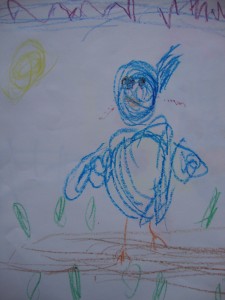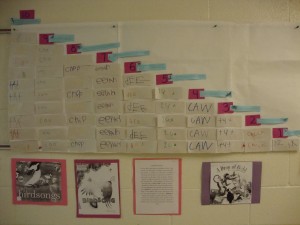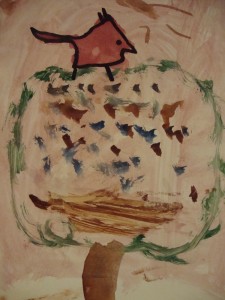“Bring awareness to the many subtle sounds of nature – the rustling of leaves in the wind, raindrops falling, the humming of an insect, the first birdsong at dawn.”
~ Eckhart Tolle
 Last summer, I camped at Long Point, a place recommended to me for its opportunities for bird watching. Waking up each morning to the sounds of so many birds was truly magical. And now that spring is here, with its array of bird songs, I have been reminded of that time and of why I need to give the calls of birds more attention. There is such a variety, and the songs are quite beautiful. Recently the children – the budding ornithologists! – in my class engaged in an interesting exploration of birds, and this presented a wonderful opportunity to learn about their songs. A while ago I came across a book by Lang Elliot called The Songs of Wild Birds, which includes a CD of bird songs. This is an excellent book because it includes photographs of birds, information about each of their songs, and sonograms (sound pictures). These are images that allow us to see what a bird’s song looks like, in a way that is similar to how musical notation allows us to see melodies. The children were quite curious to learn how bird songs and calls do things like attract mates, establish breeding territories and communicate alarm, hunger and aggression.
Last summer, I camped at Long Point, a place recommended to me for its opportunities for bird watching. Waking up each morning to the sounds of so many birds was truly magical. And now that spring is here, with its array of bird songs, I have been reminded of that time and of why I need to give the calls of birds more attention. There is such a variety, and the songs are quite beautiful. Recently the children – the budding ornithologists! – in my class engaged in an interesting exploration of birds, and this presented a wonderful opportunity to learn about their songs. A while ago I came across a book by Lang Elliot called The Songs of Wild Birds, which includes a CD of bird songs. This is an excellent book because it includes photographs of birds, information about each of their songs, and sonograms (sound pictures). These are images that allow us to see what a bird’s song looks like, in a way that is similar to how musical notation allows us to see melodies. The children were quite curious to learn how bird songs and calls do things like attract mates, establish breeding territories and communicate alarm, hunger and aggression.
This line of inquiry provided the idea to create images of birds, based on their songs. Once each child had a piece of paper and crayons, we played the Lang Elliot CD and the children drew pictures of what they thought the different birds might look like. The results that emerged from this exercise included exquisite details of birds, including their beaks, claws and feathers and birds of different shapes, sizes and colours. It was clear that the children were keen observers and could create representations of their encounters with birds. In another related exercise, the children were provided with photographs of birds, and using pens and watercolour paints they made wonderful pictures that captured their attention to many of the tiny details in the photos. Our exploration showed us what a tremendous source of inspiration birds are, both because of their songs and their beautiful plumage. It also provided the opportunity to consider other ways we might extend our inquiry into other areas of the curriculum.
each child had a piece of paper and crayons, we played the Lang Elliot CD and the children drew pictures of what they thought the different birds might look like. The results that emerged from this exercise included exquisite details of birds, including their beaks, claws and feathers and birds of different shapes, sizes and colours. It was clear that the children were keen observers and could create representations of their encounters with birds. In another related exercise, the children were provided with photographs of birds, and using pens and watercolour paints they made wonderful pictures that captured their attention to many of the tiny details in the photos. Our exploration showed us what a tremendous source of inspiration birds are, both because of their songs and their beautiful plumage. It also provided the opportunity to consider other ways we might extend our inquiry into other areas of the curriculum.
 I shared three of my favourite picture books about birds with the children. The first was A Drop of Gold by Vlasta van Kampen. This is a story about how birds got such beautiful feathers. After all of the birds are painted and decorated by the monkeys, the last bird arrives, only to find that there is not enough paint for him, except for the colour brown. He is sad because he feels so plain compared to the other birds, but there is one drop of gold paint for his throat, which gives him a song more beautiful than those of the other birds. He is named Nightingale. This lovely and imaginative story allows readers to realize that a bird with plain feathers can still be special. Birdsong by Ellie Sandall is quite a funny story that taught us about addition, and showed us what happens as more and more birds perch together on the same tree branch. It includes different bird sounds that the children can imitate. Birdsongs by Betsy Franco introduces readers to ten different birds and their calls, and includes some interesting bird facts. In addition to imitating sounds such as ‘coo’, ‘qua’, ‘eyaah’ and ‘tzik’, the children could count the number of times the word for each sound appears on the page. After printing these words, we created a chart that enabled us to practise counting backwards from ten. Our understanding of birds was enriched through additional explorations into art, drama, reading and numeracy!
I shared three of my favourite picture books about birds with the children. The first was A Drop of Gold by Vlasta van Kampen. This is a story about how birds got such beautiful feathers. After all of the birds are painted and decorated by the monkeys, the last bird arrives, only to find that there is not enough paint for him, except for the colour brown. He is sad because he feels so plain compared to the other birds, but there is one drop of gold paint for his throat, which gives him a song more beautiful than those of the other birds. He is named Nightingale. This lovely and imaginative story allows readers to realize that a bird with plain feathers can still be special. Birdsong by Ellie Sandall is quite a funny story that taught us about addition, and showed us what happens as more and more birds perch together on the same tree branch. It includes different bird sounds that the children can imitate. Birdsongs by Betsy Franco introduces readers to ten different birds and their calls, and includes some interesting bird facts. In addition to imitating sounds such as ‘coo’, ‘qua’, ‘eyaah’ and ‘tzik’, the children could count the number of times the word for each sound appears on the page. After printing these words, we created a chart that enabled us to practise counting backwards from ten. Our understanding of birds was enriched through additional explorations into art, drama, reading and numeracy!
“I’d rather learn from one bird how to sing than teach ten thousand stars how not to dance.”
~ e.e. cummings

